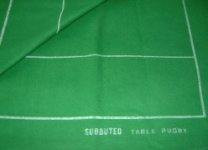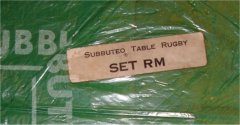
| Peter Upton's |
Subbuteo Tribute Website. |
Table Rugby |
Page 2: Accessories. |
This accessory range is for the common OO scale version of table rugby. The only accessory for the old 1950s version of the game seems to have been a set of 10 line flags (for 2s 9d), which would've been similar to Set T in the football range.

This accessory range arrived around 1969, and therefore missed out on the1960s style boxes, which the cricket accessories are found in. Like the 1970s cricket range, these accessories were provided in an inconsistent range of boxes and bags. The smaller items usually came in polythene bags, sealed with a stapled card label in brown. However, teams did get brown boxes, and so did some of the other items, especially early in their run. The scoreboard and fence surround had brown boxes (which are shown on this page), but were also supplied in the green football boxes (sometimes with rugby labels, and sometimes not). Note that the range was also labelled in an eccentric way. Where the items were the same as, or at least similar to, football items they receive a R2xx number, which matched the C1xx of the football version, whereas items that are exclusive to rugby get a two letter code starting with R (i.e. RC). However, this latter range is not in a straight alpha order, and has letters which relate to either the A-Z football range, or to the first letter of the item's name. Confusing and ill thought-out? Hmmm.



The pictures above show the different rugby figures. On the far left is the player type used almost exclusively in rugby teams (this example comes from a 1971-72 box set). I say "almost" because I have a couple in a 1968 football edition. The broad shoulders on this figure make him look more like a rugby player, but a closer look shows that the figure was designed with short sleeves. Although he is always painted with long sleeves when in a rugby set, my football versions do have the short sleeves painted as such.
As the next two figures show, the standard heavyweight figure was also used in rugby teams. The difference between the two figures illustrated are the bases, the left one being in a rugby base and the right one being in a standard football base. The rugby base was deeper than the standard football version and had indents where the rugby ball could rest, although these were only really useful for taking lineouts. The rugby base was only produced until 1975, so once these ran out, the teams were sold in plain football bases. The example here is from a 1979 international edition.
The 1981 catalogue shows that later rugby editions were also supplied with zombies, although these figures don't really look the part. The final sets used lightweight football figure. Whilst the most common place to see these later player types are in full editions of the game, both figures were also supplied in R200 teams, although they were not common. The final team shown above is a R22 Sunderland in lightweight.
For more details and pictures of rugby teams, please look at the rugby team colours page.
R201: Floodlights.

See the football range for an illustration of the actual floodlights. As with the football range, there was a Set A with two pylons, and a Set B with one pylon. I don't know if there was a rugby box for this set, or whether they just stuck a rugby sticker on the end of the usual floodlights (which seems most likely). Has anyone seen a proper rugby version?
R207: Referee and linesmen.


Yes, you've guessed it - this is the same as Set C113 in the football range (as illustrated). C113 had two different versions, and I am assuming that both sets were also sold in a R213 headed bag (there was no box produced for this item).
R217: Line flags.



This is actually a variation on C117, the football flags. That set had 4 corner flags, and two line flags. This set consisted of 10 line flags. It is different enough that it I think it should have been RL, rather than R217 :-)
The original late 1960s version of the set used the triangular flags, in a reused green football box (it looks like the Set Y box). The rectangular flags replaced the pointed version in the early 1970s. Many of the rugby accessories finally received "proper" rugby boxes in the late 1970s hobby-crest era. This brown box is now illustrated, and very nice it was too.
RC: Rules.


The rubgy rulebook saw quite a few changes down the years, as this difficult game was tweaked during production.The earliest rulebook is probably the "copyright 1969" version. This original booklet was about a centimetre shorter than the later rule books, and had the rules laid out differently. For instance, the rules bit actually started with a section on how to score a try. There is an amendment to this dated 1970 adding a few more rules including the kick-off and kicking rules.
The later booklets starting with one dated 1971 put the rules into a numbered list, starting more sensibly with the kick-off, and also clarified the basics. They also include rules for the kicking wedge, which reduced the use of the full back. Later versions were dated 1971-72, and 1978. The 1971-72 book added rules for the seven-a-side display edition. The 1978 version keeps the rules, but has to remove reference to this short-lived set. All the photos were changed for the 1978 reprint, but the rules are unaltered. The back page of the rule books advertised other Subbuteo products. The 1969 booklet listed all the Subbuteo box sets at that time (football, cricket and rugby). By 1971 this has been replaced by the rugby team and accessory lists. The 1978 version showed the increase from 26 to 37 teams, but the number of accessories had been cut back. You can read these rules on the Rugby rules (OO scale) page.


A much smaller ball than the ones in the football game. If Subbuteo rugby had continued into the 1990s, I wonder if they could have produced an advertising version of this... If anyone is at all interested, I've found two distinct colours of ball. In the older sets they are brown, in the newer ones they are orange.
RK: Kicker fullback.




The figure later borrowed for the football corner kickers, and the best bit of the rugby game. At least it is until the "divot" gets worn, and then, annoyingly, the ball just slides down the base. Unlike the corner kickers these came singly, and could be requested in any of the rugby colours. They originally came in a box, but were later switched to a bag - as illustrated.
In the pictures above, the kicker inside the box has the original base, which was only produced for the first couple of years of production. You can note that the base is grooved, and an extra rest was provided. This allowed different angles of elevation for the kicker, to simulate different types of kicks. So you could raise the angle for a classic "up'n'under", although I assume the ball had to rest against the kickers foot if you were doing this. A good idea then, but in actual play, this extra rest proved to be pointless, as you can easily get the height required without it. That's probably why it was swiftly dropped (well that and keeping the cost down).

There is also an early kicker in a different design to the "corner kicker" version which you usually see. The above scan shows the difference between the two. The early kicker (on the left) does look more like a toy, whilst the later one is much more detailed and animated.
RM: Pitch playing cloth.


The early "rolling" version of Subbuteo rugby was too simple a game to have an accessory range, so the rugby pitch was placed in the football catalogues. The 1950s rules suggest ordering set K, whilst the 1960s version had a proper marked out pitch under Set MM. When the OO scale range was introduced, this was moved to set RM.
The rugby pitch is an identical size to the football pitch, with the relevant markings of course. As usual with Subbuteo, there were quite a few variations in pitches. Some pitches had extra dotted ten yard lines each side of the half. Some had dotted lines inside the touchlines. The word Subbuteo can vary in size, or be absent altogether. The lovely pitch shown above is unusual in that it also has "Table Rugby" written on the corner. The rugby range lasted into the 1980s, so sadly just long enough for a horrible nylon version of the rugby pitch to be produced.
RN: Rugby goals.
Two rugby goals in white plastic on green base stand.


These came on a large green base (also used for C122 goals in football). Because this would interfere with play, it was recommended that the goals be placed behind the dead ball line until needed.



This was the same as the 1970s football and cricket fences, except that this one was produced in brown. As you can see, this item was issued in a brown rugby box. However, it seems just as common in the green C108 football box. In fact, the 1970s version of the green box had a place on the end of the tray where the colour of the fence (green, brown or white) could be marked.
RS: Scrummer.


A strange large rugby ball shaped item, designed to recreate something that would be impossible with the normal players. To produce a scrum, the ball is dropped in the top hole, and comes out on one side or the other, giving possession. The main problem is that this is fifty-fifty, and in real rugby, the advantage is heavily with the team with the "put-in". This simple device to produce random results is similar in make-up to the Subbuteo dicer used in the Angling game.
RW: Kicking Wedge.


It was so easy to score drop goals with the full-back figure, that the original rules limited each side to three attempts. These figures were also too good for the other kicking requirements within the game. Players would be tempted to play a constant kicking game for territory and possession (actually, that might be quite realistic these days - sigh).
This problem was solved with the arrival of the Kicking Wedge, which arrived in the 1971 rule book. The wedge was used for kicking to touch and drop goals, and also has a measure down one side for checking the "two inch" rule (for gaining possession and try scoring). The size of the wedge is also part of the rules - if you don't have room to put the wedge down on the pitch, you can't use it. The wedge makes drop goals much more tricky, because it isn't really high enough to get the right trajectory. So the limit rule on drop goal attempts was.... err.... dropped.



This is an annoying scoreboard to use, because you end up raking around the box trying to find the next number that you need. Unless you are organised and lay the numbers out beforehand (as if). So I've taken to using the cricket scoreboard for rugby, because this can cope with two numbers up to 999 on the rotating disk system.
That's it for the rugby accessory range. If you want to look at the teams available, follow the link to the rugby team colours page.
[ Main Page | Previous Page | Next Page ]